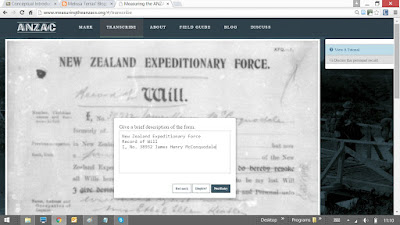For anyone
wishing to dabble in the transcription process and view digitized versions of
primary sources there are other projects out there. Indeed, there was a lot
going on in the world in 1916 from the point of view of richness of historical
artefacts. Back in those days, people kept paper records in metal filing
cabinets, and wrote letters by putting pen to paper.
An example project
is Measuring the ANZACs,
where volunteers are asked to:
Do
your part to help transcribe first-hand accounts of New Zealanders from the Australian
and New Zealand Army Corps circa World War I.
According to the NewZealand History website, about 120,000 New Zealanders enlisted during the
First World War, of whom nearly 100,000 served overseas. When the war broke out
in 1914 men flocked in their thousands to answer the call to arms. By the end
of the first week of the war 14,000 had volunteered to enlist.
 |
| Off to War: a volunteer? |
A nice feature
of the site is that you can start working immediately, no need to register and
sign in. Another important feature for getting and keeping volunteers on board
is that the website offers up an item that needs work, the volunteer is not
required to go fishing for unworked artefacts. Admittedly, there may be
questions about the quality of the marking and transcribing as volunteers do
not even need to follow the tutorials, and let’s face it most of us won’t bother
reading the help text. In this age of digital intuitiveness, we want to dive in
and figure it out as we go. In this case, this can work, as the tasks are
fairly simple, and really only require a bit of application and patience.
Another nice
thing about working on the Anzac artefacts is the continuity with regards to
the subject. With such volumes of data, it is easy to forget that we are
dealing with real people. But the project builders added a nice touch, in that
when you work on a record for a given soldier, and decide to work on the next
record, it pertains to the same person. Thus, I soon became quite interested in
the fate of Corporal James Henry McConquadale, especially when one record to
transcribe was his will. Presumably it was standard procedure for all soldiers
to make a will before going to the front?
The first
record the site presented to me was a Casualty Form:
Followed by his
Will:
Thankfully,
however, the will was followed by his Discharge papers:
You will notice
that in the first record I was unsure of the good corporal’s surname because of
the handwriting, but by the last record I think I had figured it out. There was
no way to go back to the first record and redo, so another volunteer (was James
Henry a volunteer?) will tidy that up.
'First World War
census and conscription', URL:
http://www.nzhistory.net.nz/media/photo/war-census-and-conscription, (Ministry
for Culture and Heritage), updated 23-Feb-2015



No comments:
Post a Comment